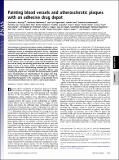| dc.contributor.author | Kastrup, Christian | |
| dc.contributor.author | Nahrendorf, Matthias | |
| dc.contributor.author | Figueiredo, Jose Luiz | |
| dc.contributor.author | Lee, Haeshin | |
| dc.contributor.author | Kambhampati, Swetha | |
| dc.contributor.author | Lee, Timothy | |
| dc.contributor.author | Cho, Seung Woo | |
| dc.contributor.author | Gorbatov, Rostic | |
| dc.contributor.author | Iwamoto, Yoshiko | |
| dc.contributor.author | Dang, Tram T. | |
| dc.contributor.author | Dutta, Partha | |
| dc.contributor.author | Yeon, Ju Hun | |
| dc.contributor.author | Cheng, Hao | |
| dc.contributor.author | Vegas, Arturo | |
| dc.contributor.author | Siegel, Cory D. | |
| dc.contributor.author | MacDougall, Samantha | |
| dc.contributor.author | Okonkwo, Michael E. | |
| dc.contributor.author | Thai, Anh | |
| dc.contributor.author | Stone, James R. | |
| dc.contributor.author | Coury, Arthur J. | |
| dc.contributor.author | Weissleder, Ralph | |
| dc.contributor.author | Langer, Robert | |
| dc.contributor.author | Anderson, Daniel Griffith | |
| dc.contributor.author | Pritchard, Christopher D., (Christopher David) | |
| dc.date.accessioned | 2013-08-01T18:31:38Z | |
| dc.date.available | 2013-08-01T18:31:38Z | |
| dc.date.issued | 2012-12 | |
| dc.date.submitted | 2012-11 | |
| dc.identifier.issn | 0027-8424 | |
| dc.identifier.issn | 1091-6490 | |
| dc.identifier.uri | http://hdl.handle.net/1721.1/79758 | |
| dc.description.abstract | The treatment of diseased vasculature remains challenging, in part because of the difficulty in implanting drug-eluting devices without subjecting vessels to damaging mechanical forces. Implanting materials using adhesive forces could overcome this challenge, but materials have previously not been shown to durably adhere to intact endothelium under blood flow. Marine mussels secrete strong underwater adhesives that have been mimicked in synthetic systems. Here we develop a drug-eluting bioadhesive gel that can be locally and durably glued onto the inside surface of blood vessels. In a mouse model of atherosclerosis, inflamed plaques treated with steroid-eluting adhesive gels had reduced macrophage content and developed protective fibrous caps covering the plaque core. Treatment also lowered plasma cytokine levels and biomarkers of inflammation in the plaque. The drug-eluting devices developed here provide a general strategy for implanting therapeutics in the vasculature using adhesive forces and could potentially be used to stabilize rupture-prone plaques. | en_US |
| dc.description.sponsorship | National Institutes of Health (U.S.) (grant DE016516) | en_US |
| dc.description.sponsorship | National Institutes of Health (U.S.) (Grant R01HL096576) | en_US |
| dc.description.sponsorship | National Institutes of Health (U.S.) (Grant U24- CA92782) | en_US |
| dc.description.sponsorship | Medtronic, Inc | en_US |
| dc.description.sponsorship | Canadian Institutes of Health Research (grant MOP119426) | en_US |
| dc.description.sponsorship | National Institutes of Health (U.S.) (Pioneer Research Program Grant R31-10071) | en_US |
| dc.description.sponsorship | National Institutes of Health (U.S.) (Pioneer Research Program Grant WCU-2z011-0001696) | en_US |
| dc.description.sponsorship | Juvenile Diabetes Research Foundation International | en_US |
| dc.language.iso | en_US | |
| dc.publisher | National Academy of Sciences (U.S.) | en_US |
| dc.relation.isversionof | http://dx.doi.org/10.1073/pnas.1217972110 | en_US |
| dc.rights | Article is made available in accordance with the publisher's policy and may be subject to US copyright law. Please refer to the publisher's site for terms of use. | en_US |
| dc.source | PNAS | en_US |
| dc.title | Painting blood vessels and atherosclerotic plaques with an adhesive drug depot | en_US |
| dc.type | Article | en_US |
| dc.identifier.citation | Kastrup, C. J., M. Nahrendorf, J. L. Figueiredo, H. Lee, S. Kambhampati, T. Lee, S.-W. Cho, et al. “Painting blood vessels and atherosclerotic plaques with an adhesive drug depot.” Proceedings of the National Academy of Sciences 109, no. 52 (December 26, 2012): 21444-21449. | en_US |
| dc.contributor.department | Harvard University--MIT Division of Health Sciences and Technology | en_US |
| dc.contributor.department | Massachusetts Institute of Technology. Department of Chemical Engineering | en_US |
| dc.contributor.department | Koch Institute for Integrative Cancer Research at MIT | en_US |
| dc.contributor.mitauthor | Langer, Robert | en_US |
| dc.contributor.mitauthor | Anderson, Daniel Griffith | en_US |
| dc.contributor.mitauthor | Vegas, Arturo | en_US |
| dc.contributor.mitauthor | Kastrup, Christian | en_US |
| dc.contributor.mitauthor | Kambhampati, Swetha | en_US |
| dc.contributor.mitauthor | Lee, Timothy | en_US |
| dc.contributor.mitauthor | Dang, Tram T. | en_US |
| dc.contributor.mitauthor | Cheng, Hao | en_US |
| dc.contributor.mitauthor | Pritchard, Christopher D. | en_US |
| dc.contributor.mitauthor | MacDougall, Samantha | en_US |
| dc.contributor.mitauthor | Okonkwo, Michael E. | en_US |
| dc.contributor.mitauthor | Thai, Anh | en_US |
| dc.relation.journal | Proceedings of the National Academy of Sciences | en_US |
| dc.eprint.version | Final published version | en_US |
| dc.type.uri | http://purl.org/eprint/type/JournalArticle | en_US |
| eprint.status | http://purl.org/eprint/status/PeerReviewed | en_US |
| dspace.orderedauthors | Kastrup, C. J.; Nahrendorf, M.; Figueiredo, J. L.; Lee, H.; Kambhampati, S.; Lee, T.; Cho, S.-W.; Gorbatov, R.; Iwamoto, Y.; Dang, T. T.; Dutta, P.; Yeon, J. H.; Cheng, H.; Pritchard, C. D.; Vegas, A. J.; Siegel, C. D.; MacDougall, S.; Okonkwo, M.; Thai, A.; Stone, J. R.; Coury, A. J.; Weissleder, R.; Langer, R.; Anderson, D. G. | en_US |
| dc.identifier.orcid | https://orcid.org/0000-0001-5629-4798 | |
| dc.identifier.orcid | https://orcid.org/0000-0001-9522-8208 | |
| dc.identifier.orcid | https://orcid.org/0000-0003-4255-0492 | |
| dspace.mitauthor.error | true | |
| mit.license | PUBLISHER_POLICY | en_US |
| mit.metadata.status | Complete | |
